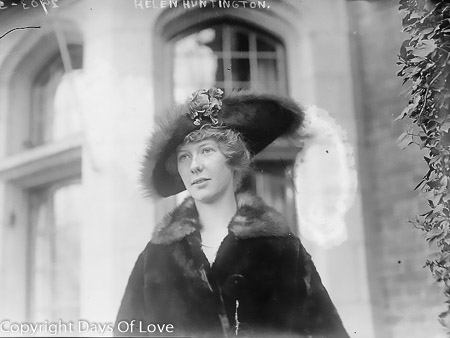

Husband Vincent Astor
Queer Places:
130 E 80th St, New York, NY 10075, USA
Locusts on Hudson, 135 Old Post Rd, Staatsburg, NY 12580, Stati Uniti
Rhinebeck Cemetery, 3 Mill Rd, Rhinebeck, NY 12572, Stati Uniti
 Helen
Huntington Hull (April 9, 1893 – December 11, 1976) was an American socialite,
arts patron, and political hostess.
Helen
Huntington Hull (April 9, 1893 – December 11, 1976) was an American socialite,
arts patron, and political hostess.
Helen Dinsmore Huntington was born on April 9, 1893, to Helen Gray Dinsmore (1868–1942) and Robert Palmer Huntington (1869–1949), an independently wealthy architect and tennis champion. She had a brother, Robert Huntington Jr, and a sister, Alice Huntington Juta (1898–1966).
She grew up in Rhinebeck, New York, at both her paternal mansion, Hopeland House, a 35-room Tudor Revival mansion designed by her father, and her maternal mansion, Staatsburg on Hudson.[1][2] Huntington attended schools in Dobbs Ferry, New York.[2]
During World War I, Huntington participated in the war effort by waiting tables for American soldiers in Brest and Bordeaux.[1]
In 1927, Astor built a townhouse for the two of them in a row that is now listed in the United States National Register of Historic Places. Designed by Mott B. Schmidt, the Vincent Astor House at 130 East 80th is now part of a block of four houses known as the East 80th Street Houses.[1][3][4]
Huntington was a lover of music and opera (she attended her first opera when she was two) and therefore helped to found the New York City Center and the New York Opera Company. She was a patron of the Metropolitan Opera on Broadway. She owned two boxes at the opera house, one she used herself and one she kept for her guests. In 1966 she was among those who attended the closing gala at the Met on Broadway, and helped found its re-opening at the Lincoln Center. She attended the inauguration gala night at The Philharmonic Hall, directed by her friend Leonard Bernstein.[5][1][6][7]
130 E 80th St
Huntington was on the board of directors of the New York City Ballet, The Metropolitan Opera, the New York Philharmonic, and the Lincoln Center for the Performing Arts.[5][1][7] She was a trustee of the Metropolitan Museum of Art.[1] She created the Musicians' Emergency Fund to support musicians, creating teaching and performing jobs.[1]
Also an accomplished piano-player, in 1942 Huntington performed at the Poughkeepsie High School in the presence of Eleanor Roosevelt. This was her only public performance.[1] After that, she continued to play into her 70s, often with her Locust-on-Hudson's neighbor, pianist Rudolf Firkušný.[8]
Among the Sierra Nevada, California is an 1868 oil painting by Albert Bierstadt. It was acquired in 1873 by William Brown Dinsmore, Huntington's grandfather; when Huntington inherited the painting, she had the canvas glued directly to a curved wall on the second floor of her new mansion, Locusts on Hudson.[7] When she died in 1976, she bequeathed the painting to the Smithsonian American Art Museum.[7]
Huntington was a good friend of Elsa Maxwell, Cole Porter, and Maury Henry Biddle Paul (aka Cholly Knickerbocker).[5][9]
In 1941, Helen inherited Staatsburg on Hudson from her maternal grandfather, William Brown Dinsmore II, head of Adams Express Company, a railroad and shipping concern. She demolished the previous mansion to build a much lighter house, known as Locusts on Hudson, that was designed by architect John Churchill in the Neobaroque style.[10][5][7][2] Her family had deep roots in politics.[a] At Locusts on Hudson, she held her gala fundraising events and raised her six dogs, and at Hopeland House, she hosted her Republican political fundraising events, attended by the likes of former U.S. presidents Herbert Hoover and Calvin Coolidge.
When, in 1913, Astor was asked if his future wife, Helen Huntington, believed in suffrage for women, he replied that she was far too sensible for that.[13]
In 1924, Huntington was an alternate delegate for New York to the Republican National Convention and in 1926 and 1927 she co-chaired the Women's Republican National Committee for New York.[11] She was a guest at the United States presidential inaugural balls of four different U.S. presidents: Calvin Coolidge, Herbert Hoover, Dwight D. Eisenhower, and Richard Nixon. She was a good friend of Nelson Rockefeller and his wife, Happy Rockefeller.
In October 1976. Huntington attended a fundraising dinner to support U.S. President Gerald Ford; this was the last event she attended before her death.
On April 30, 1914, Huntington, age 21, married William Vincent Astor (1891–1959), son of Lt.-Col. John Jacob Astor IV and Ava Lowle Willing.[b] The couple had known each other since they were children; the Astor family mansion, Ferncliff, was located just a few miles from Hopeland House.[1][6][15][11] The press described her as "a charming American girl". Helen asked Astor to choose as their main residence the Hudson Valley mansion, Ferncliff, because she did not care for society life. The wedding took place at Hopeland House and the nearby little country church. After the marriage, they went on a cruise on the Noma, Vincent Astor's yacht that was later loaned to the U.S. Army during World War I.[2][16] The couple eventually divorced at the beginning of 1941 after which she moved south to 60th Street, New York City.[1]
Huntington remarried to Lytle Hull (1882–1958), a real estate broker and an old friend of Vincent Astor, on April 15, 1941.[1][6][15][11]
She died on December 14, 1976, after a fall at her Locusts on Hudson mansion. The day of her death, the president of the New York Philharmonic, Carlos Moseley, opening the night at the Avery Fisher Hall, said that Helen Huntington Hull was "one of the great music lovers and benefactors of our time".[1] Huntington is buried in Rhinebeck Cemetery, Dutchess County.
Huntington was bisexual. Even while married to Astor in 1914, they mostly led separate lives until their divorce, with Huntington preferring the company of her female friends. Glenway Wescott once called her "a grand old lesbian".[11][17]
My published books: